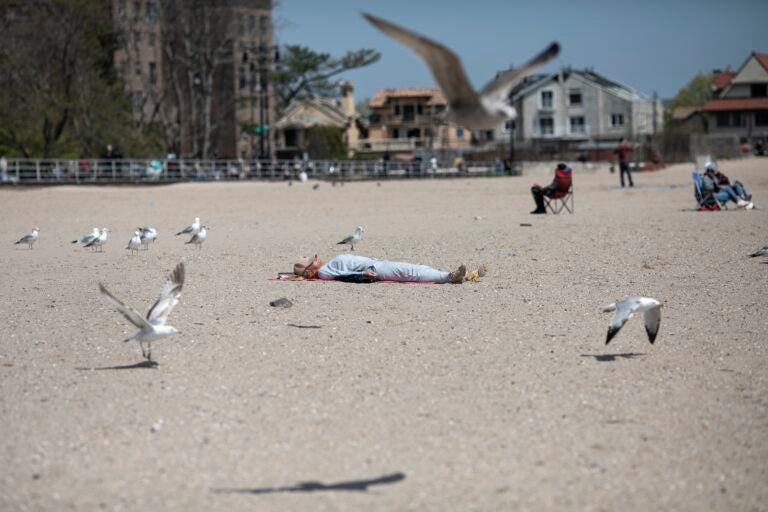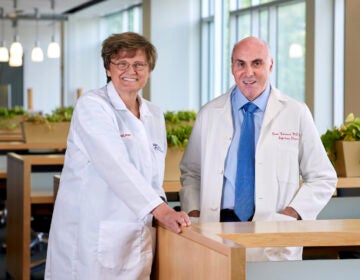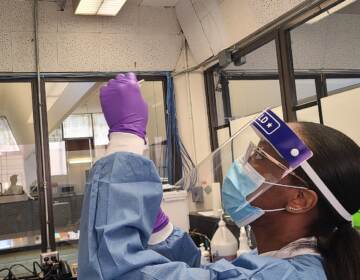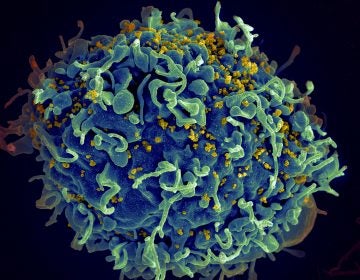What happens to the coronavirus when it gets warmer?
It’s a difficult question, but no matter what the answer is, the pandemic is not going to stop anytime soon.
Listen 1:36
A woman sleeps on Brighton beach undisturbed by seagulls fluttering around her in the Brooklyn borough of New York, on Saturday, April 25, 2020. (AP Photo/Wong Maye-E)
Updated 12:45 p.m.
Are you on the front lines of the coronavirus? Help us report on the pandemic.
What will happen to the coronavirus once summer begins?
It’s hung on pretty tenaciously as spring has progressed, despite assertions to the contrary.
President Donald Trump said it “goes away in April with the heat.” A news broadcast this week misquoted research calling 77 degrees Fahrenheit the “magic number” above which the virus doesn’t get transmitted as easily.
None of that is true. But the question is a difficult and important one to answer — one that many research groups are trying to address.
A panel from the National Academy of Sciences explained in a letter to the White House science adviser in April that researchers can do one of two things: either study the coronavirus under different temperatures and humidity conditions in a lab to see what happens to it, or look at how the pandemic does in different places with different climate conditions and try to tease out the effects of temperature and humidity.
Both approaches have drawbacks: A lab doesn’t reflect the real world, with people going around and spreading the virus, and the real world spread of the virus is affected by a lot more than just the climate.
A group of researchers answered the question differently by looking at what happens to similar viruses under different climate conditions. Because they have a lot more data for those viruses in various places, they can say: If the new coronavirus were to act like these other similar viruses, this is what would happen.
Rachel Baker, lead author of a new article in Science and a researcher at Princeton University who studies how climate affects infectious disease, said the main conclusion is that in a pandemic like the one we’re in now, what decides how quickly the new virus spreads is how many people are susceptible, or not immune, to it. Climate would play a bigger role only as more people become immune.
The bottom line is whatever effect the summer will have on the coronavirus, it is still going to be able to spread “given the high level of susceptibility in the broader population for the virus to get around and move from person to person,” said Jeffrey Shaman, a professor of environmental health sciences at Columbia University, who is not affiliated with the new study.

Get daily updates from WHYY News!
He added that it’s hard to say too much about the coronavirus because we only have months’ worth of data, unlike other viruses for which there are years of data. And whatever available data there is could vary by reporting requirements and standards in different countries: not all places document and report infections at the same level of detail.
“All of this makes it a bit challenging to actually unlock this by looking at case data or death data or hospitalization data,” Shaman said.
On a very basic level, higher temperature and humidity should slow transmission of the virus because humid air weighs down droplets in the air, said David Rubin, a pediatrician and director of PolicyLab at Children’s Hospital of Philadelphia. That’s what happens with the seasonal flu, but he agreed with Baker and Shaman that unlike with the flu, not as many people are immune to the new coronavirus so temperature and humidity changes will not stop it from spreading.
“It’s not just simple, like the higher you go, the lower the cases go,” Rubin said.
For example, there could be effects from UV radiation, from people gathering in crowds outside when it’s warm outside, and other factors.
“We’re concerned that people will relax too quickly, decide that we’re out of the woods ’cause it’s summertime, when in reality I think we have pretty clear definitive evidence in our models that the virus does not extinguish,” Rubin said. “If people overreach, then I think that we can see a surge in infection and more cases and deaths that are really, that could have been preventable.”
The spread of a virus depends on both environmental conditions like temperature and humidity and the mechanism of people who are infected spreading it to people who are susceptible. The new paper in Science takes both things into account, to lead to a more biological and realistic view of how COVID-19 could spread, said Pamela Martinez, postdoctoral research fellow at the Center for Communicable Disease Dynamics at the Harvard School of Public Health.
“When you observe the dynamics, the long-term temporal changes, of these diseases, you will observe a mix of what is happening in terms of: the number of susceptible, the number of infected, their behavior, how they are contacting; but also how the environment is playing into a role in this transmission rate,” Martinez said. “And that is why this paper is important.”
—
This article was updated to add comments from Pamela Martinez.
WHYY is your source for fact-based, in-depth journalism and information. As a nonprofit organization, we rely on financial support from readers like you. Please give today.



![CoronavirusPandemic_1024x512[1]](https://whyy.org/wp-content/uploads/2020/03/CoronavirusPandemic_1024x5121-300x150.jpg)


